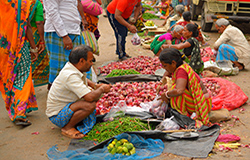Bringing a wealth of knowledge to the fight against poverty
Millennium Development Goal 1 - to cut the 1990 poverty rate by 50 % - was achieved in 2010, five years ahead of schedule. Despite these welcome advances, the global figure remains high and there are concerns about further progress. Chief amongst these is the fact that progress has been uneven, with most of the global poor lacking education, living in rural areas and working disproportionately in the agricultural sector. Key to the success of the new Sustainable Development Goal (SDG) 1 (and indeed arguably all the goals) will be a better understanding of this unevenness, to understand patterns of poverty and look for local solutions that may be transferable. This effort requires a supply of absolute and comparative data, enabling evidence based decision-making. The EU-funded NOPOOR project has studied the dynamics of poverty, investigating how and why people fall into and escape poverty, by gathering and analysing information that reflects its multidimensional nature. Getting to the devil in the detail The NOPOOR team is comprised of research teams from 17 countries, ten of which are from developing and emerging countries in three regions (Latin America, sub-Saharan Africa and South Asia). This diversity reflects the various barriers to escaping poverty, as well as different experiences in policies aimed at reducing poverty. NOPOOR conducted 18 original surveys, analysing qualitative and quantitative data, including modelling future scenarios. Data was collected from more than 10 000 people in Burkina Faso, Ecuador, India, Peru, Madagascar, Mali, Ghana, Niger, South Africa and Vietnam. What is especially valuable about the surveys is their capture of the non-monetary dimensions of poverty such as: segregation and discrimination; violence; absence of rights; accountability of representatives and, inequalities among household members. This richness of information is more instructive than a single aggregate index. For example, researchers from NOPOOR published results of their work in India, which were recently reported in the Indian e-paper ‘Livemint’. The researchers found that real earnings increased at all percentiles between 2004-05 and 2011-12, and also that inequality had fallen over the same period. Yet, they also discovered that globalisation had contributed to the existence of two Indias, ‘One of educated managers and engineers who have been able to take advantage of the opportunities (...) and the other - a huge mass of undereducated people who are making a living in low-productivity jobs in the informal sector - the largest of which is still agriculture’. One conclusion they draw is that owing to factors such as climate or global pricing volatility, ‘policies designed to foster the employment opportunities and wage growth of unskilled workers outside agriculture are crucial for improving the economic well-being of the rural workforce in India’. Providing a cornerstone for SDG indicators Looking at both global and local poverty levels, the project suggests a net positive globalisation effect on employment and wages, informed by factors such as trade, aid, FDI and migration. However, when looking at specific situations, global trends do not impact countries the same way. The work does point to some policies that can tackle the root causes of poverty, such as better access to public goods, quality of education, greater participation and ‘voice’ for the poor, protecting women against domestic violence, etc. However, it also finds that there are no ‘catch-all’ universal policies for poverty eradication but only those that work because they are appropriate for the local context. NOPOOR highlights just how important data is for the pursuit of the new SDGs and its research aligns well with their indicators. Indeed, the project actually provided input to stakeholders developing Goal 16 on Governance, Peace and Security, for example drawing on its research on African populations’ perception of governance. In this way NOPOOR advocates for the ongoing importance of statistical surveys and so it also champions the support of National Institutes of Statistics (NIS). Towards this end NOPOOR has collaborated with, and built capacity within, NIS in particular in Senegal, Mali, Madagascar, Vietnam, Haiti and Peru. The project data, which has been systematically uploaded to the ‘data warehouse’ portal, has been actively disseminated to relevant decision-makers and is also intended for public access. For more information please see: project website
Countries
France



